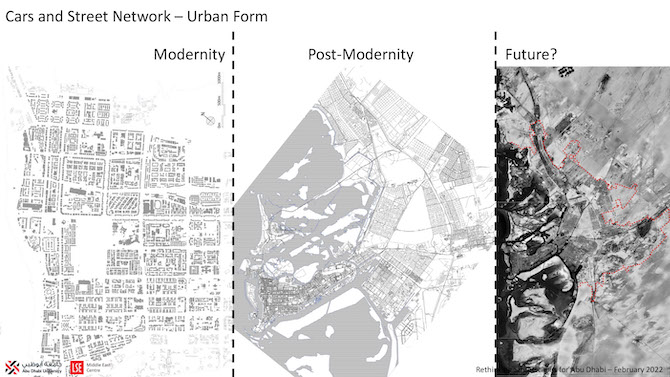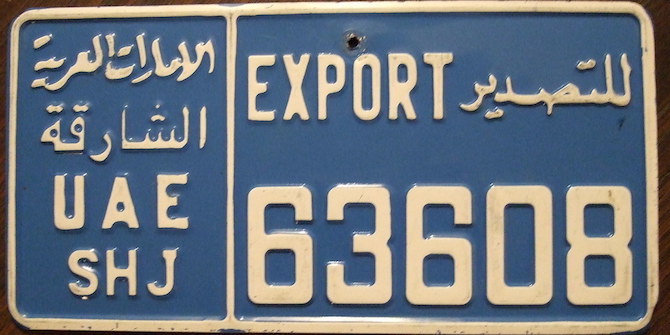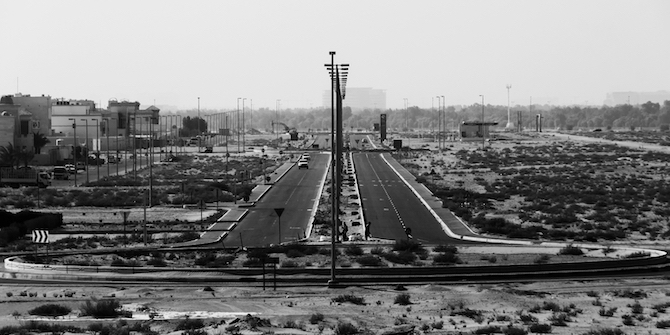by Apostolos Kyriazis, Alexandra Gomes, Clemence Montagne & Peter Schwinger

On 10 February 2022, a roundtable titled ‘Rethinking streetscapes for Abu Dhabi’ was hosted online by the Department of Architecture and Design at Abu Dhabi University. The roundtable formed part of an LSE Middle East Centre academic collaboration project that includes researchers from Abu Dhabi University and LSE Cities, titled ‘Roads as Tools for (Dis)connecting Cities and Neighbourhoods: a Socio-spatial Study of Abu Dhabi’. This project seeks to explore Abu Dhabi’s car-centric development and the role of road infrastructure in forging socio-spatial conditions.
The aim of the roundtable was to acknowledge the current challenges of Abu Dhabi’s car centric urban development and rethink the role of roads under the new dynamic conditions, such as climate change, resources, socio-economic conditions, mobility and so forth. The overarching questions were: who is designing, who do we design for, how could the streetscape/urban form vicious circle break, and what new urban mechanisms could contribute to this? This event focused solely on local knowledge, local lived experiences and local social and spatial practices. Key representatives from Abu Dhabi authorities, educational institutions, developers, and consultancies participated in a compact yet vibrant discussion over two and a half hours. Being held online due to pandemic restrictions provided the opportunity to use a Miro board to take notes, summarise ideas and identify patterns from the discussion.
The roundtable opened with a discussion: what are the best neighbourhoods of the city to live in, according to the participants’ own lived experience, devoid of the usual urban criteria. Frequent reference was made to specific areas of downtown within the ‘watermelon’ superblocks. Criteria hinged upon the human scale, valuing low to medium density morphologies, proximity of schools and the abundance of ground level retail.
Following suit, the session was divided into three discussion points. The first discussion focused on ‘Neighbourhoods, their current morphologies, and their resident’s needs’. In this discussion, the human scale was mentioned again, as well as the concept of time. Time and its appreciation as a dynamic force is imperative in managing layers of memory – and in creating a feeling of belonging, as an action of resistance at a city of constant recycling, of both buildings and people.
The second discussion, on ‘Current rules and regulations’, focused on governance and the transition from roadscapes to streetscapes. Since 2010, Abu Dhabi has conducted unprecedented shifts in design practices (by improving the Urban Street Design manual and by rationalising downtown parking areas), however, extreme climatic conditions will always remain a challenge for public space use and mobility. Several participants mentioned the existence of a dual governance system, as well as a dual streetscape design approach, implying a distinct treatment for gated communities in the most affluent suburbs. Another special mention regarded the negative (undeveloped) patches of the urban tissue that are difficult to maintain in the long run and impact overall accessibility, mobility and consequent urban cohesion.
The third and final discussion revolved around ‘Pattern disruptions and future scenarios’, on priorities and necessary changes that could push for alternative spatial and social practices. In other words, how would the applied current manuals, guidelines and Estidama principles – the local sustainability guidelines, similar to the LEED system – transform spaces into better cycle and pedestrian-friendly, connected and lively neighbourhoods? Several participants emphasised the need to shift to automated transport, to transport zoning for different modes, to freight transport and to micro-mobility as a factor that could forge neighbourhood forms. The idea of breaking ‘artificial’ barriers, such as building volumes or walls, to promote pedestrian flows was a widely accepted idea. The discussion then moved to the aforementioned negative transitioning areas – major empty urban patches for future development, such as the Capital District project and the west end of Raha Beach – and an apparent gap on existing manuals with regards to regeneration projects and connections of newly designed areas with much older neighbours. In general, participants identified the need for disruptions to create order while allowing change at the same time. An interesting twist led to the discussion of the Emirati housing schemes, their extremely low densities and disproportionate waste of land and resources through sprawl. In this discussion, it was pointed out that suburbia has made Abu Dhabi a very expensive city, as population estimations have failed, and it is becoming harder for the city to support the street network. The resultant question posed, ‘who pays for the streets?’, was indicative, given the specific governance system.

To close the workshop, a summary session based on the miro board allowed the team to introduce some of the key points taken from the discussion. These points, listed below, were not based on any question, but rather tried to preserve key highlights from the participants’ contributions: (i) a call to developers to respect existing manuals by providing the promised and much needed mid-income housing; (ii) a call to authorities to be more sceptical on ‘curated streetscapes’ and to promote more open-programmed ones instead. As these are more walkable and more pleasant for the urban population; and a (iii) a call to design truly liveable communities, to ‘make people care’ and to preserve a healthy street-level, neighbourhood-scale retail, with more softscape and footpath flexibility. Lastly, (iv) it was acknowledged that the existing manuals were overall successful but need to be updated with chapters on retrofitting and urban regeneration.
According to most of the participants, this roundtable provided a unique opportunity for all those key players to gather around the same table and compose ideas on the future of the city in a less formal tone. It was also critical in conveying an image for a city that needs to adapt to future changes, lead the way amongst other cities in the region and become a paradigm for resilience.
It was an honour for Abu Dhabi University to host such an event and for our research team to welcome its distinguished guests in a thorough and constructive discussion.
This blogpost is a product of a collaborative research project between LSE and Abu Dhabi University titled ‘Roads as Tools for (Dis)connecting Cities and Neighbourhoods: a Socio-spatial Study of Abu Dhabi‘. The project forms part of the Academic Collaboration with Arab Universities Programme, funded by the Emirates Foundation.






